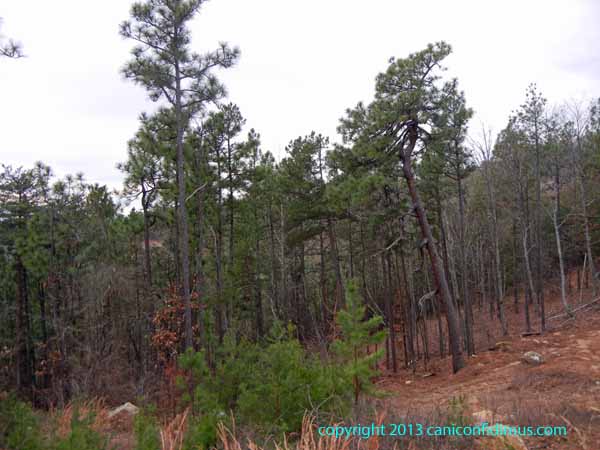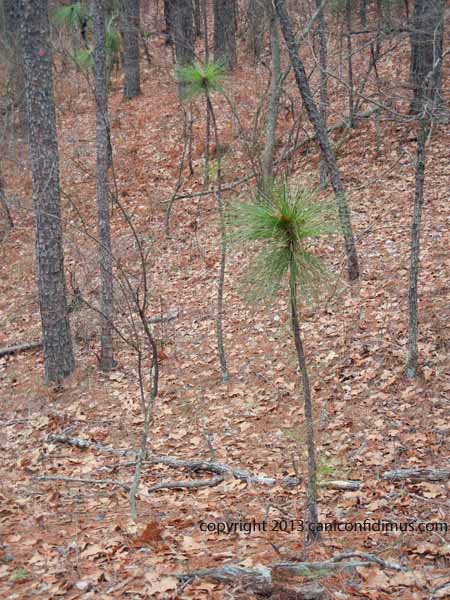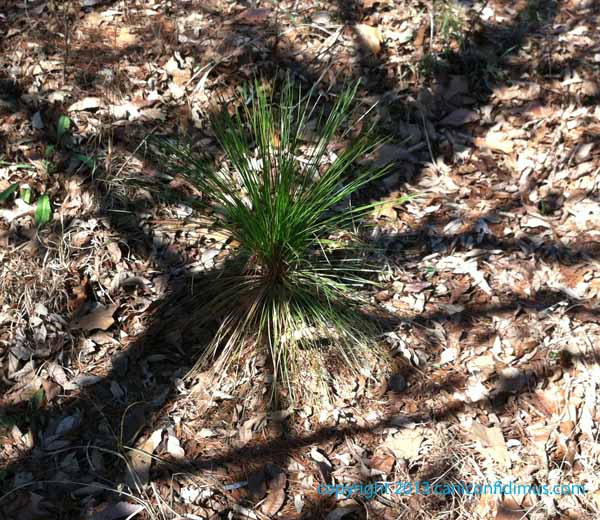My father was born in Floyd County, up in northwest Georgia where we live now. He grew up here, and spent almost his entire life here. He roamed the fields and woods, and he learned to recognize and name most of the plants and animals of this area. He could name just about any bird from its call, and he knew the names of pretty much all the trees. In all the years I spent here, I never once heard him mention the longleaf pine (pinus palustris). We had pines in our back yard, but those were loblollies. There were some Virginia pines around, and a few white pines. The longleaf was completely unknown to me.
But back before the Europeans came to North America, the longleaf pine covered huge areas of the southeastern United Stages, stretching along the coast from Texas to Virginia, and from the coast to the foothills. There are several good sources of information about the longleaf, including one at Auburn University, and one right here next to us at Berry College. One source estimates that longleaf pine forests covered 140,000 square miles. That’s a lot of longleaf pines. Another source estimates that those forests now cover about three percent of the former range. Today, if anyone thinks about the longleaf, they usually think of it as a tree of the coastal plain. I imagine some people whose blogs I read have them around, like Florida Cracker. They may take them for granted. But not me. Not up here in the foothills, far from the coastal plains.
What made the longleaf disappear from so much of its range? Well, it was us, of course. Europeans. We used them for lumber, and we tapped them for turpentine. And when we reforested, we replaced them with faster-growing species like the loblolly. One perhaps unexpected problem for the longleaf was fire suppression. The longleaf is fire resistant, and in fact dependant on that to outcompete other trees and establish healthy stands. With periodic, fairly low-level fires sweeping through the longleaf forests, other types of trees were killed. The longleaf, in all its stages, was more able to withstand fires. So once we started suppressing all fires, both natural and man-made, one of the longleaf’s major advantages disappeared. Not too far over the border from us in Alabama there is a fairly large stand of longleaf pines at Fort McClellan. Military training there inadvertently maintained the longleaf ecosystem through accidental fires. That type of training has stopped, though, and other types of trees have begun to encroach on the longleaf forests.
For many years I never saw a longleaf pine that I recognized as such. I don’t think the idea of a longleaf pine even crossed my mind. That may explain why it took me so long to realize that I was walking through a nice stand of longleaf pines on Lavender Mountain when I took the dog for a walk. I became aware of the fact slowly, and I’m not even sure how. I had walked Zeus, my old dog, around the woods up where we live for quite a while before I realized that I was walking through a longleaf stand. They are mixed with other pines and oaks, but there are actually quite a few, and some nice, big ones.

Mature longleaf pine
In this picture, the large tree to the right is a longleaf pine. The shorter trees in the foreground are loblolly pines. Behind the big longleaf there are some more longleaf pines and loblollies, along with the typical chestnut oaks that form the majority of the hardwood forest on Lavender Mountain. This lot has been partially cleared and trails have been bulldozed to allow the owner and his friends to drive their off-road vehicles.
I did some reading, and the more I read, the more interested I got. I found the Berry College longleaf pine restoration project in the link above. I thought maybe they didn’t know of the stand near our house, so I contacted Martin Cipollini, who runs Berry’s project. I had suspected that Lavender Mountain was close to the most inland and upland extent of the pine’s range, and he confirmed that, although he said there is another stand somewhat further north.
Once I realized what the longleaf pine was and how it looked, I started seeing them here and there around the mountain. The longleaf has a distinctive look to the needles. Most of the other pines in this area tend to grow needles along the length of a branch up to the tip so that they look like a horse’s tail. The longleaf grows its needles in a round clump at the end of a branch. It looks like a cheerleader’s pom pom. I find it fairly hard to tell some loblollies from a longleaf under some circumstances. Their needles can be long enough to confuse me, a naïve observer. But I usually have no confusion when I actually see a longleaf. That means that if I’m not sure, it’s almost certainly not a longleaf.
There are singletons scattered around, if you know to look for them. I was a little envious to find one growing on an adjacent lot just down from us, near our property line. I almost convinced myself it is on our side of the line, but it isn’t. And then I was excited to find a big one growing on the lower slopes of our lot, surrounded by other types of pine. It’s really hard to see, and I have to convince myself occasionally that it’s really there. It’s surrounded by the weed-like Virginia pines that colonize the disturbed landscape, and a few loblollies. But it’s there. (Now I have to check again.)
These longleaf pines are remnants of the huge stands that were so characteristic of the southeastern forest. They survived the loggers and the sap collectors because they were up on steep ridges that made harvesting the trees impractical. They have remained there for many years, like isolated pools left on the beach as the tide recedes. I think it has probably been at least a century since the rest of the longleaf forests in this area were finally eliminated.
It’s an interesting tree, and different from the other pines of this area. Most pines grow fairly quickly from seedlings, and from the beginning they have a shape not too unlike their mature form. But the longleaf grows slowly, especially at first, and in three distinct stages. The first stage is called the grass stage. In this stage, it is a clump of needles at ground level that looks more like ornamental grass than a tree. Apparently this stage can last up to seven years. At some point, depending on the growing conditions, it initiates upward growth. The trunk will grow, pushing a pom-pom of needles upward with no lateral branches. I have seen trees in this stage up to around six feet tall. This stage is called the bottlebrush stage. It doesn’t usually last as long as the grass stage, but I have seen some that don’t seem to have changed for several years.

Longleaf in the bottlebrush stage
There are at least two longleaf pines in the bottlebrush stage in this photo. There is one in the background that looks like it might be just starting to branch out. They are quite distinctive, and unlike other pines at this stage of their growth.
A tree in the bottlebrush stage continues to grow comparatively quickly for a few years, eventually sprouting branches and growing taller. It takes the longleaf about 30 years to produce fertile seeds and a tree can live 300 years. There are some reports of trees up to 120 feet tall. None of ours are anywhere near that big. I have no idea how old they are.
I have found a few grass stage longleaf pines on the slopes and in the woods not far from our house. I have also seen some grass stage and adult trees destroyed by off-roaders and by companies contracted to keep powerline rights of way clear of trees. I have watched a couple of large trees slowly decline and die, I assume as a result of the large gashes on their sides caused by off-roaders scraping by them. So when I found several grass-stage trees in areas where I knew they could not survive, I dug them up and brought them home. Unfortunately, it turns out that the grass stage tree, although not tall, can have a deep taproot. Because of the areas where I found them, it wasn’t possible to excavate very deeply, and I ended up unable to get much of the taproot. I took five home. Three died fairly quickly. One survived a couple of years and then died. One has lived. It’s overshadowed by the Virginia pines that infest this area, but I have thinned some of their limbs and the little longleaf actually seems to be doing pretty well. It has continued to sprout new needles and get larger. In fact, it is just starting its development into the bottlebrush stage.

Our baby longleaf
I might be optimistic, but I think it’s starting to show a little trunk under there.
People who live in areas with healthy longleaf forests might wonder why they seem so fascinating to me. But they are rare up here now, and I get some satisfaction from helping at least one little longleaf baby along its journey in life.